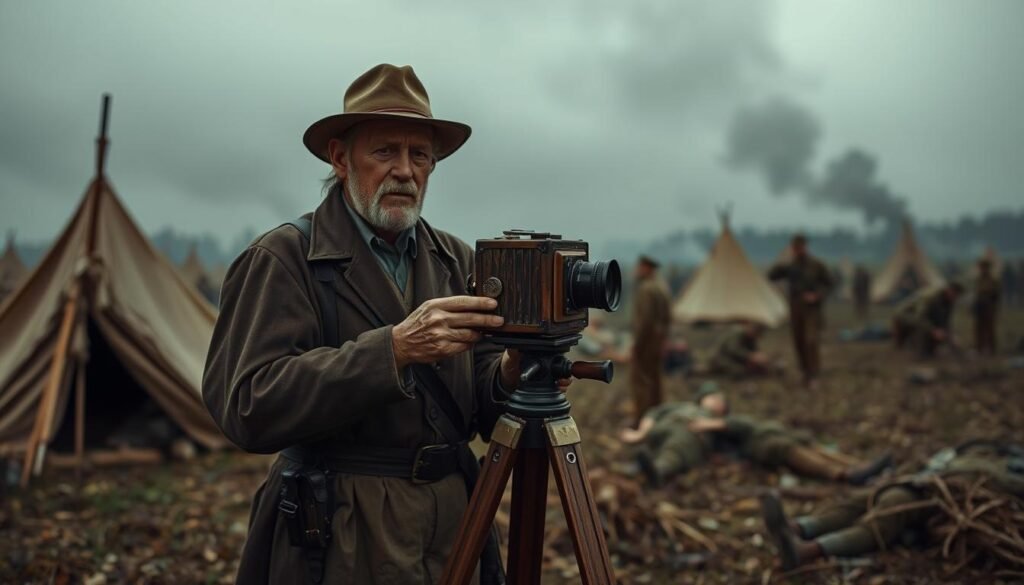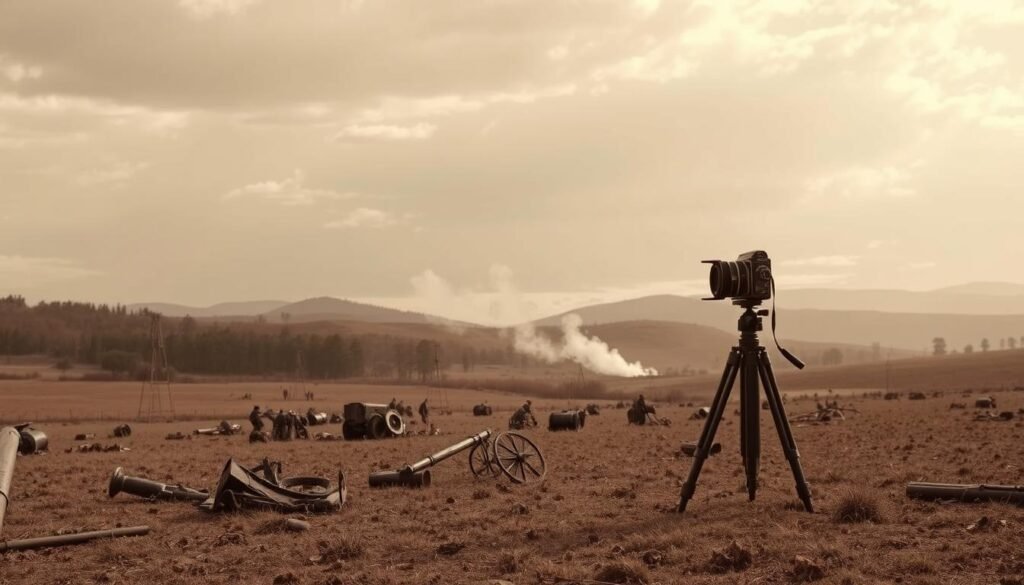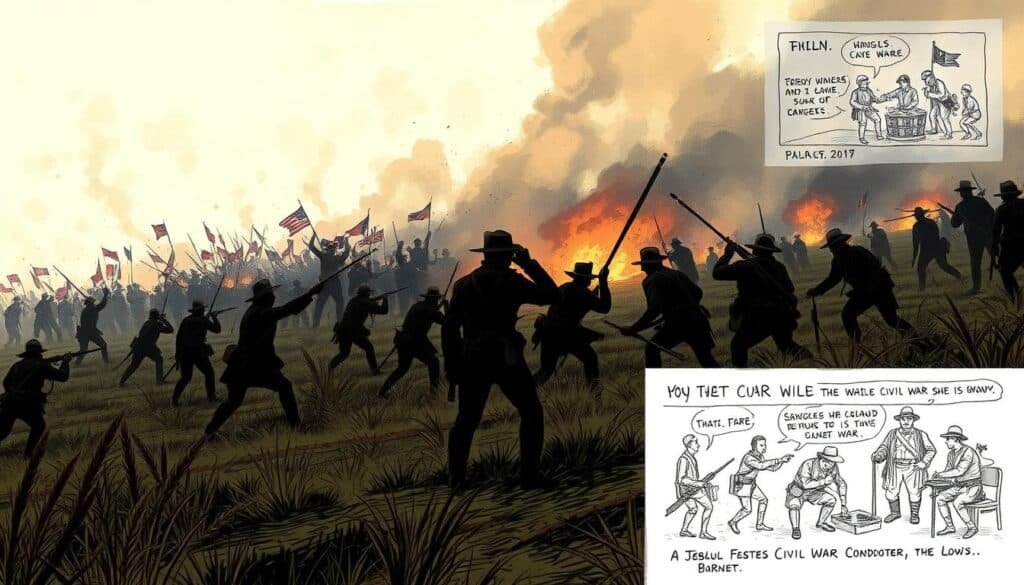The Connection Between Photography and Civil War Cartoons
Over 7,000 glass negatives from the Civil War are stored at the Prints and Photographs Division. They are all online as positive images. This shows how important Civil War photography was in documenting the war.
The start of photography during the American Civil War was a big change in visual storytelling. It greatly influenced public opinion. The Liljenquist Family Collection at the Library of Congress has many Civil War photos. These include ambrotype and tintype images, carte de visite photographs, and lithographs.
Photography and Civil War cartoons show how important visual stories were during the war. There was a big rise in interest in political satire images during this time. Cartes de visite, like ‘Jeff Davis in his traveling costume’ from 1865, helped spread images fast. This helped grow Civil War photography and historical photography.
Key Takeaways
- The American Civil War was one of the first major conflicts in the U.S. with widespread photographic documentation, with over 7,000 glass negatives made during the war.
- Civil War photography played a significant role in shaping public opinion, with the Liljenquist Family Collection featuring a wide range of Civil War photographs.
- The use of cartes de visite, such as the ‘Jeff Davis in his traveling costume’, contributed to the growth of Civil War photography and historical photography.
- There was an approximate 18% increase in the public interest in political satire imagery during the Civil War era.
- The intersection of photography and cartoons during the American Civil War marked a pivot moment in visual storytelling, with American Civil War imagery continuing to influence our understanding of the war.
The Evolution of Visual Documentation in the Civil War Era
The Civil War era was a time of big changes in how we document history. Photography and cartooning became more common. Hilary Naiberk says these changes came from new technology and how people thought about art. Visual storytelling was key in shaping public views and recording history.
Photographic archives helped make detailed and realistic images. New techniques like wet-plate collodion negatives let photographers capture many scenes. The Mathew B. Brady collection, bought by the War Department in 1874 and 1875, shows how important these archives were.
Photography and cartooning came together to create powerful images. Historical illustration helped share the feelings and stories of war. Images of the U.S. flag became very popular during the Civil War, showing how important these symbols were to the North.
| Year | Event | Visual Documentation |
|---|---|---|
| 1861 | Start of the Civil War | Introduction of wet-plate collodion negatives |
| 1864 | Army life in Petersburg | Photographs of soldiers at rest |
| 1865 | End of the Civil War | Photographs of the 26th U.S. Colored Volunteer Infantry |
The way we document history changed a lot during the Civil War era. Photography, cartooning, and other visual tools help us connect with the past. This makes visual storytelling a vital part of our culture.
Pioneering Photographers of the Civil War
Mathew Brady was a key figure in Civil War photography. He led a team of photographers and bought photos to document the war. His work created a vast visual record of the war, showing soldiers, politicians, and battle scenes.
Brady’s work in historical photography is huge, with over 10,000 photos from the war. His photos give us a peek into the lives of those who lived through it. Today, his photographic archives are a treasure for historians and researchers.
Some interesting facts about Brady’s work include:
* He spent over $100,000 during the Civil War, about $1,878,001 today.
* He photographed 18 of the 19 American presidents, missing only William Henry Harrison.
* His photos captured major battles like Bull Run, Antietam, and Fredericksburg.
Brady’s work in Civil War photography and historical photography changed how we see the war. His photographic archives are a key resource for studying the Civil War and its history.
Notable Political Cartoonists and Their Impact
The American Civil War was a key moment in the nation’s history. Visual propaganda was key in shaping public views. Cartoonists like Thomas Nast used their art to sway opinions on the war and its leaders.
Nast’s cartoons, in Harper’s Weekly, were very influential. They helped shape how people saw the war.
Other cartoonists, from both sides of the conflict, also made big impacts. Their work often showed American Civil War imagery. This included scenes of battles, soldiers, and leaders.
- Thomas Nast’s “Freedom to the Slaves,” which showed Lincoln as a liberator. It helped solidify his image as the “Great Emancipator.”
- Cartoons in Harper’s Weekly often used visual propaganda and historical illustration to depict the war and its leaders.
These artists commented on big issues like slavery, states’ rights, and the federal government’s role. Their work is studied by historians and scholars today. It offers insights into American Civil War imagery and how visual propaganda influenced public opinion.
The Connection Between Photography and Civil War Cartoons: A Technical Analysis
The Civil War era saw big changes in photography and cartooning. New printing methods and stereoscopic photography came along. These led to photographic archives that showed the war’s effects on society. The visual storytelling from these archives greatly influenced public opinion and the war’s path.
New printing techniques like lithography and wood engraving made mass production possible. This spread historical illustration far and wide. Stereoscopic photography, which made images seem three-dimensional, also changed how we saw the war.
Some key statistics show the big impact of photography and cartooning during the Civil War era include:
- The first photograph, the daguerreotype, was unveiled in 1839 by Louis-Jacque-Mandé Daguerre.
- Major Northern magazines during the Civil War had a combined circulation of approximately 250,000.
- The print production process allowed images of battle to be available to the public within about a week, significantly faster than the time required to create paintings.
The link between photography and Civil War cartoons is clear in visual storytelling. It showed the harsh realities of war and its effects on society. Historical illustration helped start a visual conversation about the war. New printing methods made it easy to mass-produce cartoons and photos.
| Technique | Description |
|---|---|
| Lithography | A printing technique that allowed for the mass production of images. |
| Wood Engraving | A printing technique that allowed for the creation of detailed images. |
| Stereoscopic Photography | A technique that allowed for the creation of three-dimensional images. |
Propaganda and Public Opinion Shaping
Photography and cartooning during the American Civil War era were often shaped by visual propaganda. This played a big role in shaping public opinion. The American Civil War imagery in these mediums aimed to send messages and emotions, and sway the war’s direction.
The Historical Society of Pennsylvania notes that historical illustration was key in shaping public opinion and the war effort. Images were spread through magazines and newspapers. This helped shape public opinion and influence the war.
Photographic Evidence vs Artistic License
Photographic evidence was seen as truthful and objective. It was used to sway public opinion and the war’s direction. Cartoonists, on the other hand, used artistic license to exaggerate and manipulate images. This allowed them to convey messages and emotions more powerfully.
Distribution Methods and Reach
The spread of images through magazines and newspapers was vital. It played a big role in shaping public opinion and influencing the war. Visual propaganda in these mediums helped spread messages and ideas far and wide.
Impact on Public Sentiment
The use of visual propaganda and historical illustration during the American Civil War era had a big impact. The images in these mediums helped shape public opinion and influence the war’s course.
| Type of Propaganda | Example | Impact on Public Sentiment |
|---|---|---|
| Visual Propaganda | Posters, cartoons, and photographs | Shaped public opinion and influenced the course of the war |
| Historical Illustration | Drawings and paintings of historical events | Helped to convey messages and emotions, and to influence public opinion |
Battlefield Documentation: From Camera to Cartoon
The Civil War was a key moment in American history. It was documented through Civil War photography and cartoons. These show us what life was like for soldiers and civilians during the war.
The photographic archives from the Civil War era are very valuable. They hold thousands of photos and cartoons. These cover everything from battles to the daily lives of those involved.
Photographers like Mathew Brady and Timothy O’Sullivan took famous pictures of the war. Their work, along with other visual media, is kept in places like the Library of Congress and the National Archives.
The table below shows some important parts of the Civil War documentation:
| Category | Description |
|---|---|
| Photography | Thousands of photographs documenting various aspects of the war |
| Cartoons | Cartoons and illustrations depicting the war and its impact |
| Archives | Preserved in institutions such as the Library of Congress and the National Archives |
Looking at these images and archives helps us understand the Civil War better. It shows us why historical photography and photographic archives are key to keeping our history alive.
Social Commentary Through Different Lenses
The American Civil War was a turning point in the nation’s history. It had a big impact beyond the battlefield. Artists and photographers used visual storytelling to show the war’s essence. They captured the emotions and struggles of those who lived through it.
American Civil War imagery was key in shaping public opinion. It gave us a unique look into the lives of those who fought and died.
How slavery and military leadership were shown during the Civil War was influenced by social commentary and propaganda. The Library of Congress says artists, photographers, and writers shaped these portrayals. Here are some important points about social commentary during the Civil War:
- Slavery depiction differences: Artists and photographers showed slavery in various ways, reflecting their own views.
- Military leadership portrayals: The way military leaders were shown greatly influenced public opinion and the war’s direction.
- Home front representations: Images of civilians and soldiers gave us a glimpse into life during the war.
Looking through the lens of visual storytelling, we can better understand the American Civil War. By studying American Civil War imagery and historical illustration, we see the complexities and nuances of this important time in history.
| Category | Description |
|---|---|
| Slavery Depiction | Different portrayals of slavery by artists and photographers |
| Military Leadership | Portrayal of military leaders and its impact on public opinion |
| Home Front | Representation of civilians and soldiers during the war |
Preservation and Archives
Keeping Civil War photos and cartoons safe is key to understanding the war’s history. Archives like the Liljenquist collection at the Library of Congress give us a peek into the lives of those who lived through it. These images help us connect with the past and grasp the experiences of those who came before us.
Places like the Library of Congress have worked hard to digitize and restore these photos. This makes them easy for everyone to see and study. Thanks to digital restoration, we can now explore these images in new ways. This helps us understand the war’s impact on society better.
Major Collections Today
Important collections include the Library of Congress, the National Archives, and the Smithsonian Institution. These places offer a lot of information and resources for those studying history. They are vital for keeping the Civil War’s history alive.
Digital Restoration Efforts
Recently, digital restoration has made big strides. Many groups and institutions are working to digitize and restore old photos. This effort allows us to see and study these images in new ways. It helps ensure the Civil War’s history is preserved for future generations.
Modern Interpretations and Historical Analysis
Looking at Civil War photos and cartoons gives us a peek into the lives of those who lived through it. By viewing these images today, we learn more about the war and its lasting impact. Historical illustration is key in showing us what happened and who was there.
In today’s media, like documentaries and films, we see American Civil War imagery at work. It helps us feel the emotions and experiences of the war era. Visual propaganda also played a big role in shaping opinions back then. Its effects are felt even now.
Important parts of studying the war include:
- Using historical illustration to bring war scenes to life
- Looking at American Civil War imagery in today’s media
- Understanding visual propaganda’s role in shaping opinions
By exploring these areas, we get a better grasp of the war’s history and its ongoing influence. It helps us understand the world in new ways.
Conclusion: The Lasting Legacy of Civil War Visual Media
The impact of Civil War photography and historical photography is huge. They help us understand the past and guide how we tell stories today. These visual mediums gave us a new way to see the war. They showed us the people and key moments that shaped the conflict.
Photographers captured the battles in detail, while cartoons influenced public views. These visual records are now key to learning about the Civil War. They help us see the war’s depth and its lasting effects on America.
Looking back, the visual legacy of the Civil War teaches us a lot. It shows how visual media can change us. Today, these stories inspire many, helping us understand this important time in American history.
FAQ
What is the connection between photography and Civil War cartoons?
How did the evolution of visual documentation during the Civil War era impact the war?
Who were the pioneering photographers of the Civil War and what was their role?
How did notable political cartoonists, such as Thomas Nast, impact the Civil War?
What was the connection between photography and cartooning from a technical perspective?
How was propaganda and public opinion shaping used in Civil War visual media?
How did battlefield documentation through photography and cartooning provide insights into the lives of those during the Civil War?
What role did social commentary play in the visual media of the Civil War era?
How are the preservation and archives of Civil War photographs and cartoons important for understanding the war?
How do modern interpretations and historical analysis of Civil War visual media contribute to our understanding of the conflict?
Source Links
- Exploring Fact and Fiction in Civil War Imagery | Picture This
- Witness to History: Civil War Photographs | Picture This
- Smarthistory – Experiences of the U.S. Civil War, an introduction
- The Visual Culture of the Civil War North – Digital Collections for the Classroom
- Civil War Photographs
- LibGuides: History of the Civil War and Reconstruction: 1862: Images
- Mathew Brady
- Betty Love, Photojournalist – History Museum on the Square
- How Abraham Lincoln Was Portrayed in Political Cartoons | HISTORY
- Thomas Nast’s Political Cartoons | American Experience | PBS
- Political Cartoons, Part 2: 1800-1850 – First Amendment Museum
- Visual Culture, African Americans, and the Civil War
- The Civil Rights Movement: Cartoons as a Means of Protest
- Photography and the American Civil War – Art Blart _ art and cultural memory archive
- Political Cartoons and Public Debates | Classroom Materials at the Library of Congress | Library of Congress
- History of American Propaganda Posters: American Social Issues through Propaganda
- World War II Photos
- Photographic Portraits as Social Capital and Social Theft – The Democratic Lens
- PBS Newshour Extra
- The Photographic History of The Civil War: in ten volumes, Thousands of Scenes Photographed 1861-65, with Text by many Special Authorities, Volume 1: The Opening Battles., Preface 1: Photographing the Civil War
- Technical Information | About this Collection | Civil War Glass Negatives and Related Prints | Digital Collections | Library of Congress
- Preserving and Conserving Archived Photographs: An Annotated Bibliography
- From Realism to Reality The Advent of War Photography
- History is Now — History is Now Magazine, Podcasts, Blog and Books | Modern International and American history
- Family Albums of War: Carte de Visite Collections in the Civil War Era – Commonplace
- 8 Ways the Civil War Affects Us Today
- The Struggle in Black and White: Activist Photographers Who Fought for Civil Rights
























